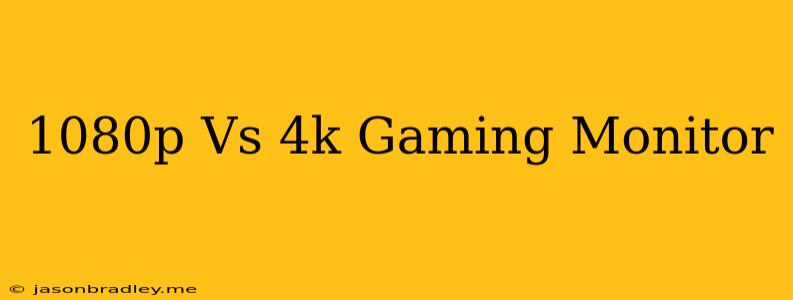1080p vs 4K Gaming Monitors: Which Resolution Reigns Supreme?
The world of gaming monitors is a vast landscape, with resolutions ranging from 1080p to 8K. But for most gamers, the choice boils down to two popular options: 1080p (1920x1080) and 4K (3840x2160). While both offer a captivating gaming experience, choosing the right resolution depends on your budget, hardware capabilities, and personal preferences. Let's break down the pros and cons of each to help you make an informed decision.
1080p: The Budget-Friendly Champion
Pros:
- Lower Price: 1080p monitors are significantly cheaper than 4K counterparts, making them accessible to a wider range of gamers.
- High Refresh Rates and Response Times: 1080p monitors often boast higher refresh rates (144Hz, 240Hz, even 360Hz) and faster response times, leading to smoother gameplay and a competitive edge in fast-paced games.
- Wide Availability: There's a huge selection of 1080p monitors available with various features, from basic models to high-end gaming panels.
- Lower Hardware Requirements: Running games at 1080p is less demanding on your GPU, allowing for smoother performance with a wider range of graphics cards.
Cons:
- Less Detail: Compared to 4K, 1080p displays less detail and sharpness, especially noticeable in larger screen sizes.
- Limited Immersion: The lower resolution can make certain environments feel less immersive, especially in open-world games with vast landscapes.
4K: Immersion and Detail at its Finest
Pros:
- Exceptional Detail and Clarity: 4K offers four times the pixels of 1080p, resulting in incredibly sharp and detailed visuals.
- Immersive Experience: The increased resolution creates a more immersive gaming experience, especially in games with stunning environments and intricate details.
- Future-Proof: 4K is rapidly becoming the standard resolution for gaming, ensuring your monitor remains relevant for years to come.
Cons:
- Higher Price: 4K monitors are considerably more expensive than 1080p options.
- Demanding Hardware: Running games at 4K requires a powerful GPU and CPU to maintain smooth frame rates.
- Lower Refresh Rates: Many 4K monitors have lower refresh rates than 1080p models, impacting gameplay smoothness.
- Smaller Screen Sizes: Achieving the full benefits of 4K often requires larger screen sizes, which can be more expensive and may not be suitable for all setups.
Choosing the Right Resolution
Ultimately, the best resolution for you depends on your individual needs and preferences. Here's a guide to help you decide:
- Budget: If you're on a tight budget, 1080p is the more affordable option.
- Hardware: Ensure your GPU can handle the demands of 4K gaming before investing in a 4K monitor.
- Gaming Style: If you prioritize smooth gameplay and fast response times, 1080p with a high refresh rate might be ideal. If immersion and detail are your top priorities, 4K is the way to go.
Remember: There is no one-size-fits-all answer. Consider your budget, hardware, gaming style, and personal preferences to find the perfect gaming monitor resolution for your needs.
